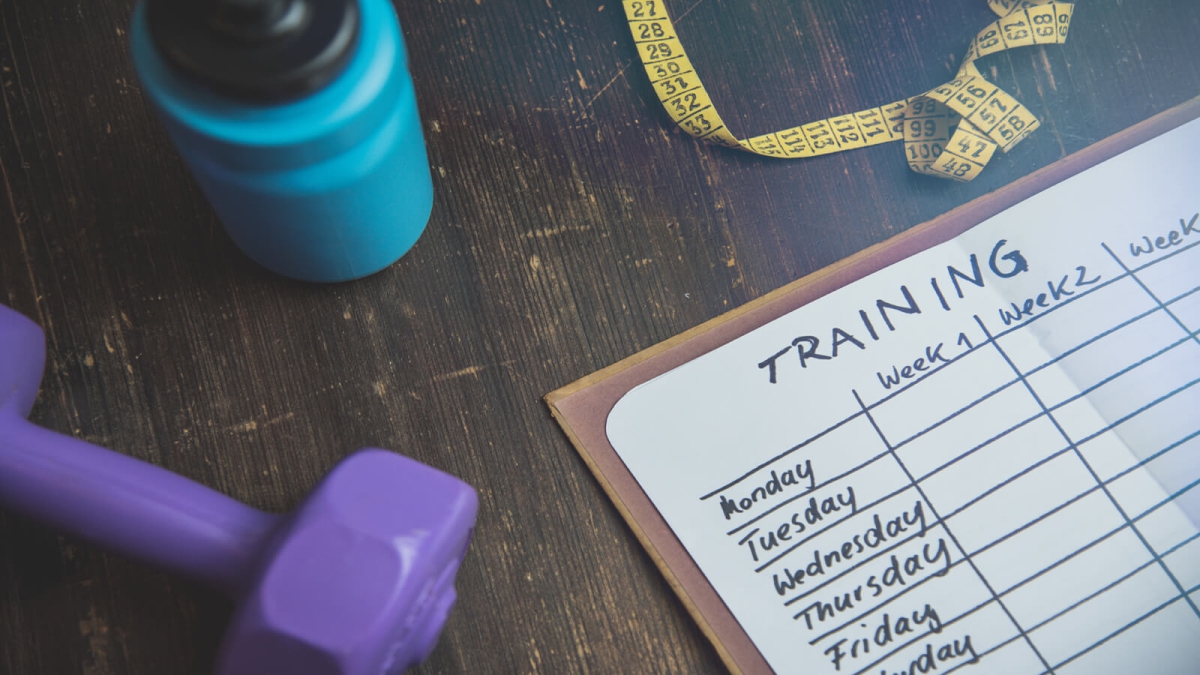A Lifelong Exercise Plan

Without a doubt, the best way to reach a goal is to plan out the journey, execute your plan, track your progress, and make adjustments along the way. Think about your health and fitness goals as your finish line. With your goals in mind, you can create an exercise plan that will act as a roadmap guiding you through the difficult terrain. A well-rounded exercise plan will address your schedule, workout location, and current fitness level. It’ll also address potential speedbumps, roadblocks, and traffic jams along the way. The barriers that get in the way of exercise can easily bump your workouts down the to-do list, but knowing them beforehand will help you avoid repeatedly missing out on opportunities to exercise.
The first item on the agenda is a consultation with your physician. After being cleared for exercise and getting notified of anything to avoid while exercising, turn your attention to the time of day and the place or space where you will exercise. Consider your daily schedule, the time of your peak energy level, and your necessary downtime, then come up with days and times throughout the week that you would be most likely to exercise. If you’re not a morning person, eliminate that timeslot right away. Don’t fool yourself into thinking that you’ll change your habits to accommodate exercise. Starting a fitness program is challenging enough. Similarly, if you’re too tired after arriving home from work, your ideal timeframe rests somewhere between the late morning and early evening. Take some time to think about the roadblocks in your life so that when barriers present themselves, you’re equipped with the tools you need to break them down and keep moving forward.
While you’re thinking about the time you plan to work out, take the place into consideration as well. If you need to travel to your exercise location, you’ll need a longer window of time. Maybe you want to set aside a space in your home, in which case you need to consider the associated costs, variety of equipment, and safety of the space. Maybe you want to cycle in the Tour de France, a very ambitious goal. In this case, your exercise plan would address issues such as the weather conditions and terrain of the race. To prepare, you might want to consider training on certain bicycle trails at specific times of the day.
Before starting an exercise program, you’ll want to assess your fitness level. You can do this on your own or with the help of a personal trainer. Whichever way you choose, be sure that the tools being used to measure your progress are relative to your goals. If your goal doesn’t involve weight loss or gain, then the scale isn’t an important measurement tool. If you’re looking to get stronger, you can use benchmark exercises as your measurement of progress. Choose a relatively light weight, and pick an exercise that uses the muscles you’re aiming to strengthen. Keep the weight the same each time you do the benchmark exercise, and do as many repetitions as possible. Time is another useful mechanism for measuring your progress. Measure the amount of time you can hang from a pull-up bar or how long it takes to run a quarter mile. These types of tests can be taken as often as weekly to track strength and endurance gains in targeted areas or muscles.
Now that you’ve established your baseline, set some short-term goals that will reinforce your hard work. That way, you can look back at your starting point and feel confident that you’re moving in the right direction. Let’s say your current dress size is X, and your goal is to lose five sizes in the next four months. Body measurements like clothing, hip, or bicep size can be taken monthly to track progress. Breaking down a long-term goal into several short-term goals can keep you motivated when you’re hitting a wall and struggling to achieve something that feels unreachable. It also gives you opportunities to assess your program’s efficacy and make changes where necessary.
Even though you may be hyper motivated and ready to go all-in, hold back at first so you don’t get burned out, overly sore, or injured. Your exercise plan should have you starting slowly and gradually progressing in intensity. Thirty-minute sessions of exercise three to five days a week are the perfect starting point for beginners. Recovery times are longer for novice exercisers, so be sure to schedule rest days.
After about four weeks, your body should be acclimating to the activity. Now is the perfect time to turn it up a notch and burn some of that excess energy you’ve been saving. When you increase your workout intensity, monitor important vital signs like your heart rate and breathing rate, and adjust your level of exertion to stay within your target zones. Take a few minutes of rest every so often to allow your heart rate to recover. Your resting time can be passive and involve no movement, such as standing still or sitting, or active, such as walking or riding a bike. Passive recovery may be right for an amateur bodybuilder, while active recovery might better suit someone with a weight-loss goal.
Remember that movement promotes blood circulation, which moves nutrients throughout your body and carries waste and byproducts to their ultimate destination of removal. Pay attention to the time it takes your heart rate to slow down from intense activity, as this recovery time can be a great indicator of your fitness level. As your workouts progress, the amount of rest you need in thirty minutes of exercise should lessen. After about six months, you may be able to exercise for the entire session without stopping. You’re no longer a beginner at this point, and if you haven’t already hit your goal, you’re well on your way.
During the first six months, learn the basics and proper form of the movements you commonly use. For example, golfers want to increase the distance they can drive a ball while still maintaining accuracy. Their training includes learning about the muscles that work together to perform a golf swing, as well as the function of each muscle. Only when they understand their muscles can they train them to work together harmoniously. Knowing the proper joint angles, ranges of motion, and body positions will help produce a consistent result.
Exercise routines should be fun, different, and exciting so that they keep your attention long enough for you to notice results. A well-rounded exercise plan will include cardiovascular exercise as well as resistance/strength training, especially for those with the goal of overall health and wellness. Rather than visiting the gym at the same time every day to do the same set of exercises, try to find a few different routines you can incorporate throughout the week to keep your body guessing what’s coming next. Arnold Schwarzenegger said it best when he described the “shocking principle” in his 1977 documentary Pumping Iron. This principle states that since your body knows all of your tricks, you have to change your routine regularly to keep shocking your muscles. If you notice your progress slowing down or your motivation being interrupted, it’s time to apply this principle to revitalize your exercise routine.
Finding the proper way to measure and track your progress is important. Keep it simple, and measure only what you are trying to improve. If you want to lose weight, weigh yourself one to two times a week at the same time of day under consistent conditions. Right after waking up is the perfect time for a weigh-in. The scale usually verifies your progress, but if weight loss isn’t the goal, think of other fun ways to track your success. One of the best measurements is a quick look in the mirror. As you begin to notice changes and improvements in your body shape and size, check yourself out a little more often and learn to be comfortable with what you see.
It takes about six to eight weeks of consistent and progressive exercise to understand if a plan is working. In the first week, you’re likely to notice some increased energy and self-confidence as you realize that it’s possible to stick with your plan. After about four weeks, you might notice a change in the fit of your clothes. You may need to tighten your belt, or you might feel some extra room in the midsection of your shirts. After another four weeks, your results should be measurably improved.
The majority of us want to maintain an overall healthy body composition, look and feel good, and age gracefully. This goal of lifelong wellness is quite common, and the ideal exercise plan consists of thirty minutes of cardiovascular exercise three days a week along with thirty minutes of resistance training twice a week. This routine can be considered a baseline workout for healthy adults and can be adjusted according to your lifestyle and needs. Wednesdays may be busy with work and extracurricular activities, and that means no time for exercise. Take the thirty minutes you had planned for that day and spread them out over the other four days, or increase the intensity of your Tuesday and Thursday workouts to stay on track.
Now that you’ve been reliably exercising for more than six months, it’s a good time to review your exercise plan and make any necessary adjustments. Use your data from the last six months to go over what’s worked and what you’ve enjoyed. Take some time to go over your goals and priorities again. Your attention, direction, and focus are fluid, and they are continually evolving. A truly well-designed exercise plan will be structured but open to adjustments based on other aspects of your life. If nothing in your life has changed, then keep going. Create new goals as they’re presented to you, and adapt your exercise plan to last a lifetime.
*****
Ali Othman is an NSCA-certified personal trainer with over a decade of experience in the health and wellness industry. He also works in the Technical Department at IFANCA® and manages IFANCA business activities in South Korea.
Reprinted from the Summer 2021 issue of Halal Consumer© magazine with permission from the Islamic Food and Nutrition Council of America (IFANCA®) and Halal Consumer© magazine.

















